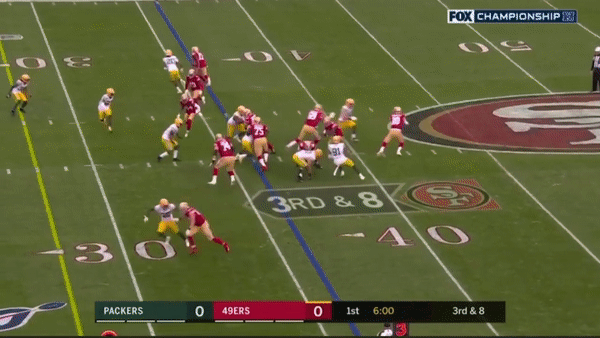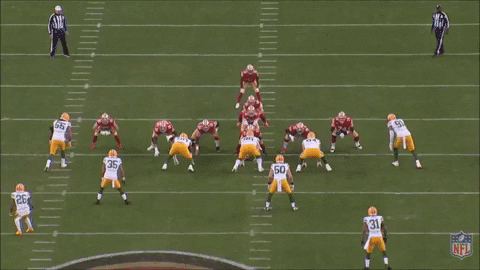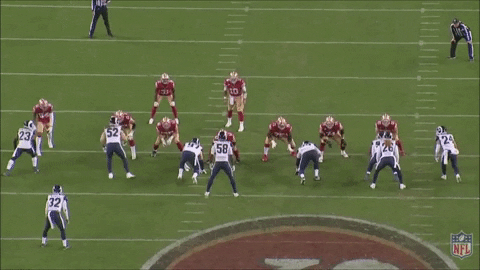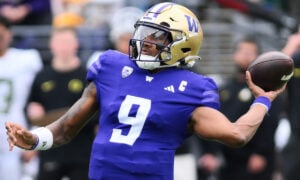The 49ers Running Back Situation
I think one of the most intriguing areas in fantasy sports at the moment involve the San Francisco 49ers backfield. Kyle Shanahan employs an attack that boasts a strong and creative running game, which is the backbone of the offense.
The team rushed 498 times this season, which was the second-most in the NFL. They did so with three undrafted running backs and a third rounder in Tevin Coleman. Nobody knows what the future holds for this team, so I’m going to dissect the position and attempt to figure out the value of their players moving forward.
The last few draft classes have been somewhat thin at the running back position. The 49ers chose to spend in free agency to fill their needs, giving $38 million in contracts to two running backs in Jerick McKinnon and Tevin Coleman. However, the leading rushers over the past two seasons were undrafted running backs Matt Breida and Raheem Mostert.
The 49ers have a running back by committee (RBBC) approach to running the ball. The game plan seems to revolve around a different running back each week, depending on what team they are playing. If they need more speed, they go with Matt Breida. If they need power they gameplan with Tevin Coleman. If they need a little of both, Raheem Mostert has been the choice.
Jerick McKinnon
First I’m going to focus my on attention on McKinnon, and this one will be quick. He signed a rather large contract back in 2018. He has zero carries in his time as a 49er because of his injury history, and it’s questionable if he’ll ever be able make an impression with the team.
He has a cap hit of $8.5 million next year and a $9.2 million cap hit the year after that. Going by the current market trends in the NFL, I doubt that the 49ers brass will see this as a worthwhile investment. Keeping him next year would make him the seventh highest-paid running back in the league for the 2020 season.
My guess is that McKinnon will be cut and both sides will move on. It’s not worth trying to retain a guy who has never proven he can handle the workload of an NFL season, and it’s not worth paying him to find out.
Tevin Coleman
Coleman is only 26 years old and has great familiarity with the system. He was brought into San Francisco because they needed a veteran they can rely on to stay injury-free. For the most part, he’s been exactly that.
The downside with Coleman is that he’s not an elite talent in any one measurable area. Devonta Freeman was the head honcho with the Falcons because the system required elite lateral speed. Coleman does not have that. He has good mid-4.4 speed, which is good enough for most systems, but not necessarily for the one Shanahan employs.
Coleman only signed a two-year deal with the 49ers. He counts $0 against the cap in 2020, and therefore could be cut with no penalties before next season. If he’s still on the roster, the 49ers will be required to pay him $5 million for his services.
I don’t think this is a bad deal, but given that he will be the 12th highest-paid running back in the league at this price, I think it’s worth considering that Coleman may become a cap casualty when this season ends.
He ran 137 times for 544 yards. He tacked on an extra 180 yards receiving, but this kind of output doesn’t exactly make for a great ROI for the 49ers. My guess is that the team will part ways with him after this season and use one of their many draft picks to fill a void on the cheap.
Matt Breida
Breida signed a three-year deal as a rookie free agent before the start of the 2017 season. He’s performed well in spurts, often as a fill-in when someone else got hurt. He’s had a lengthy list of soft-tissue injuries in his career. He weighs under 200 pounds, and has a body that cannot withstand constant punishment over the course of a season.
I think you see where I’m going with this, so I’ll just come out and say it: Breida is a backup at best. He has great speed and talent, he can catch out of the backfield, and he can break long runs at any point in time. But he’s not an every down back, and attention for his services will be limited as a result.
He is a RFA after this season. I think the 49ers will make a case for him to stay in San Francisco, as this is a team that can and will best utilize his talents. He’ll always have a role in every game, and he will still be counted on to spell other players during the season.
With the depth of talent available at the running back position in the upcoming draft, and the price it would cost other teams to acquire him, I don’t think he will have the option to go anywhere else. I do not see a future other than as a career backup in San Francisco. If you own the starting running back for the 49ers in 2020, Brieda will be a must-own handcuff.
Raheem Mostert
I’m going to end with the guy that everyone has been asking about the most. Everyone wants to know if this is the guy to lean on in the foreseeable future, or if the constant rotation of running backs will continue in San Francisco.
Mostert entered the league in 2014, bouncing around until 2017 when he landed in San Francisco. His elite speed made him a candidate for special teams, which is how he latched on with the 49ers. He even made a special teams fumble recovery in the NFC Championship Game versus the Packers, so his versatility is an important element to this team.
The question is whether his success is due to his talent or Shanahan’s ability to game-plan to perfection. I tend to think it’s a little bit of both, and I’m going to do my best to showcase why Mostert’s ability is the perfect match for this system, and why he’ll be the main guy to own going forward.
Mostert has been called a speed demon who boasts 4.3 speed, but to truly evaluate a running back’s speed I like to use game film on long runs. Linebackers and safeties are trained at all levels to take the best angle to pursue the ball carrier. These are elite athletes who have been trained well, so only those with deceptive speed will be the ones to showcase that talent at the NFL level.
In the opening drive in the NFC Championship Game, Mostert was handed the ball on a third-and-eight trap play in which he ran nearly untouched to the end zone. The offensive line and play calling was heralded as the true champions on the play, but I think a large piece should also be given to the sheer speed of Mostert.
In the image below, you can see the safety on the left desperately trying to run laterally seven yards downfield, and a cornerback a good step ahead as well. Despite the positioning of the defenders, Mostert was able to use his natural ability to score an easy touchdown where he went untouched.

Here is the same play in gif format. Pay special attention to the safety as he runs into frame, and the moment when he realized he took the wrong angle on the play, completely underestimating Mostert’s elite speed.

I can’t stress enough how amazing this is. The job of a safety is to be the last man back to eliminate deep plays. He took an angle he assumed to be good enough and completely whiffed on the play so badly that he didn’t even touch the runner.
I could show samples of Mostert’s speed all day, but when combined with his agility as well, he becomes a dangerous weapon in open space. The 49ers love to run outside zone, which exemplifies his strengths to the fullest.

In the gif above, the 49ers run another outside zone, which forces the defense to cover the complete left side of the field. The speed of Mostert must be respected, so linebackers and safeties alike must be prepared simultaneously for sideline runs and cutbacks.
In the play above, the safety was caught out of position. He can still make a play, but Mostert’s speed, agility, and quickness allows him to zip through the line, avoid two open-field tackles, and gain 30 yards. Notice how he turns on a dime and doesn’t lose speed in the process.
Having elite speed is one thing. Having agility and quickness is another. Shall we look at his vision before we finalize my thoughts? Here’s a play that I still can’t get over. It went for zero yards but should have been a loss of two or three.

Mostert is supposed to follow the pulling guard. Instead, the guard gets swallowed up in the center and is unable to complete the play. Joe Staley, theAll-Pro left tackle, assumed the Rams DE Samson Ebukam would run inside, but instead he runs up the field.
This play is doomed from the beginning as the Rams played it perfectly. Mostert’s eyes and attention were not supposed to be on the outside. However, he somehow sees the danger on his left, jump-cuts to safety, and manages to use his athleticism to get back to the line of scrimmage.
This kid is an amazing talent. The 49ers locked him up with a three-year deal earlier this season, so he’s not going anywhere in 2020. The downside is that he will be 28 years old in April.
In conclusion, I think we’ll see the 49ers retain the services of Breida, while simultaneously releasing the duo of Coleman and McKinnon. Mostert will be the presumptive starter in 2020, but his rising age and short contract may limit his time with the team in the long run.
Given the 49ers success with undrafted running backs, and the fact that the 2020 class is loaded with talent at the position, I wouldn’t be shocked to see them draft a running back or two on day three. Shanahan’s system seems to be the main driving force behind the success, but it’s been proven that it takes a stable of backs to make it happen.
I think Mostert’s value is around a late first, so a good sell-high on him would be a mid-first. A good buy-low would be any second rounder. Our rankers currently have Mostert at 140, so I’d consider trading someone in the 120-135 range for him if possible.
Several teams have been able to acquire him for a couple third rounders, which would be a great move if you could make that happen. Check out the recent trade activity using DLF’s Trade Finder to get a sense of where other owners are valuing him.

- 2023 Dynasty Riser, Faller and Longshot Predictions: San Francisco 49ers - July 28, 2023
- The Dynasty Value of Trading a 2023 Rookie Pick for a 2024 Pick - May 19, 2023
- How and Where to Pick Running Backs - May 15, 2023


































































